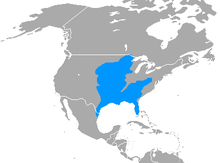Eastern spotted skunk
| Eastern spotted skunk | |
|---|---|
 |
|
| Scientific classification | |
| Kingdom: | Animalia |
| Phylum: | Chordata |
| Class: | Mammalia |
| Order: | Carnivora |
| Family: | Mephitidae |
| Genus: | Spilogale |
| Species: | S. putorius |
| Binomial name | |
|
Spilogale putorius (Linnaeus, 1758) |
|
 |
|
| Range of Spilogale putorius | |
The eastern spotted skunk (Spilogale putorius) is a small, relatively slender skunk found throughout the eastern United States and in small areas of Canada and Mexico.
This small skunk is more weasel-like in body shape than the more familiar striped skunk. The eastern spotted skunk has four stripes on its back which are broken in pattern, giving it a "spotted" appearance. They have a white spot on their forehead. They are found in Canada (southeast Manitoba and northwestern Ontario), the United States and northeastern Mexico. Males, at 46.3–68.8 cm (18.2–27.1 in) in total length, are large than females, at 35–54.4 cm (13.8–21.4 in). The tail accounts for roughly a third of their total length. Body mass can range from 0.2 to 1.8 kg (0.44 to 3.97 lb), with males averaging around 700 g (1.5 lb) against the female's average of 450 g (0.99 lb). Skull length is 43–55 mm (1.7–2.2 in). The Eastern spotted skunk is a very small skunk, which (for comparison sake) is no larger than a good-sized tree squirrel.
They are much more active than any other type of skunk. They have mostly the same predators as any other skunk (big cats, bobcats, owls, humans, etc.). Up to eight skunks may share an underground den in the winter. They can also climb and take shelter in trees.
Eastern spotted skunks seem to prefer forest edges and upland prairie grasslands, especially where rock outcrops and shrub clumps are present. In western counties, it relies heavily on riparian corridors where woody shrubs and woodland edges are present. Woody fencerows, odd areas, and abandoned farm buildings are also important habitat for Eastern Spotted Skunks.
Spilogale putorius possess a small weasel-like body with fine, dense black fur that has 4 to 6 broken, white stripes. Two of the stripes are located at the median of the body and four stripes are placed on the side running from the back of the head to the rear. White markings are present on both cheeks, as well as on the tip of the tail. This is known as an aposematic fur pattern and is thought to act as a warning to predators.
The typical body length of eastern spotted skunks is 24 to 26 centimetres (9.4 to 10.2 in) with a tail length from 11 to 19 centimetres (4.3 to 7.5 in), resulting in a total length of 35 to 45 centimetres (14 to 18 in). The feet are 40 to 53 millimetres (1.6 to 2.1 in) long, and the forefeet have claws approximately 7 millimetres (0.28 in) long, while the hind feet have claws that are around 3.5 centimetres (1.4 in). The feet are equipped with pads on the soles that aid in climbing. The large claws of the forefeet help the skunk dig and grasp prey. The total body weight of adults ranges from 400 to 965 grams (14.1 to 34.0 oz).
...
Wikipedia

